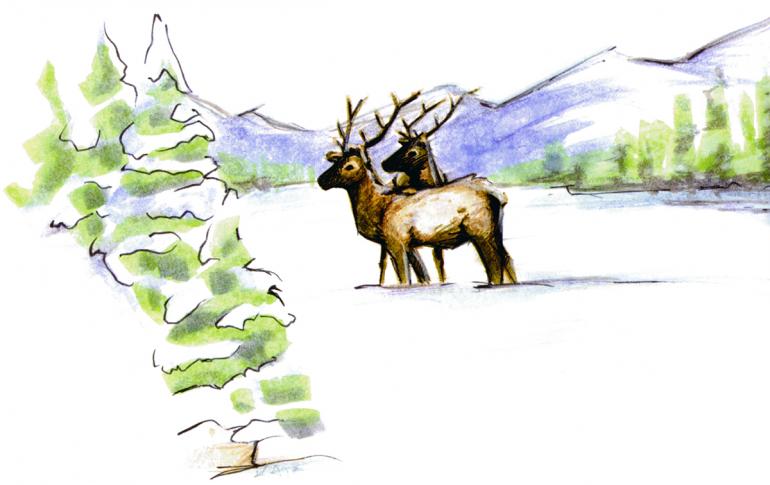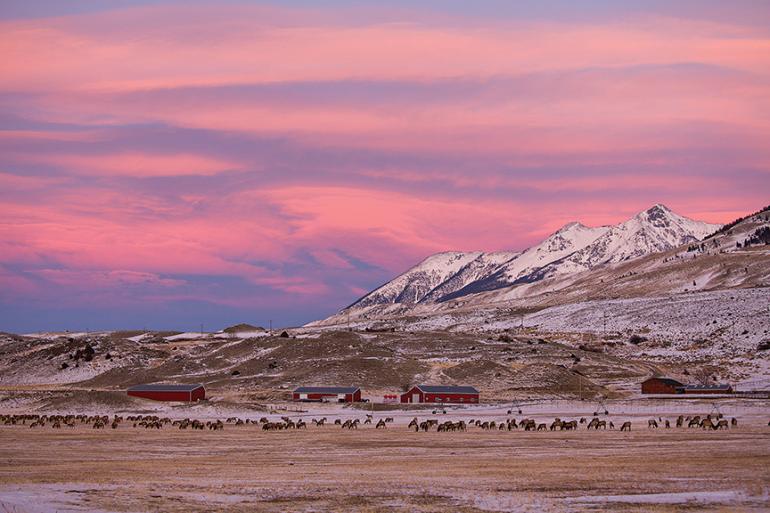Winter Range
Where the wild things go.
Now that it’s winter, it’s easier to observe some of our large grazing animals. Elk, mule deer, bighorn sheep, and bison cluster at lower elevations to spend the winter season. Biologists and range managers refer to these areas as “winter range.”
There is no way these animals can eat enough in winter to meet their energy needs. The plants, which these animals typically eat, are dormant for the winter season and since the grass is not growing and the deciduous shrubs and trees are not producing leaves, the greenery that makes up the bulk of their diet simply isn’t available. Winter is therefore the most stressful time in the annual cycle of seasons for these animals.
Because they cannot find enough winter food to maintain body temperature, these large grazing animals must rely on stored energy. During the comparatively mild seasons of spring, summer, and fall, elk and deer will graze extensively and consume more than they need to survive. The extra energy will be stored on their body as fat. Fat, of course, is an efficient way to store caloric energy. During the course of the winter, the animal will metabolize this stored fat energy to generate heat to stay alive.
If the animal has stored enough fat and the winter is moderate, it will probably survive. If the animal has not stored enough fat and the winter is particularly harsh, then it will probably deplete its energy reserves and die. When elk or deer die as a result of winter stress, biologists refer to this occurrence as “winter kill.” Since stored energy is so crucial for survival, it benefits these animals to conserve their body fat.
Typically these large grazers such as elk and mule deer will adopt a survival strategy that conserves their energy stores. Those that live in the mountains will migrate to lower elevations to find warmer air temperatures and lower snow depths. They may also inhabit wind-blown areas where they do not have to walk through deep snow and where they may find some forage from the previous growth season. These characteristics are typical of wildlife winter range.
Winter range can therefore be identified by lower elevation, open wind-blown and south-facing slopes, and proximity to higher-elevation, summer-range habitats. In general, this translates into mountain foothills.
Once identified, these areas can provide exceptional winter wildlife viewing opportunities. In our region, one of the most dramatic winter range areas is the “Northern Range” of Yellowstone. This includes areas both in and out of the Park, roughly from the Lamar Valley to Emigrant, Montana. Time spent searching for wildlife within this region, with its central focus at Gardiner, can result in observation of thousands of elk; hundreds of mule deer, pronghorn, and bison; dozens of bighorn sheep; and, of course, the occasional scavengers and predators—wolves, coyotes, eagles, hawks, and ravens which may take advantage of those animals too weak to survive the harsh reality of the winter season.
While the “Northern Range” is fairly well known, there are isolated sites, which provide winter-range habitat that receive less attention. When you go afield this winter, pay attention to where you routinely see grazing wildlife. For example, large male elk and deer tend to inhabit more rugged and less accessible areas than the females. Their winter habitat may be more difficult to recognize and identify. But in general, the same individuals may return year after year.
Note that this winter range habitat is critical to the survival of not only the individual animal, but the population as well. Consider the possibility of disturbance…free-ranging dogs and those intrepid souls they bring with them. Too much disturbance can cause the loss of body fat, too.
Ken Sinay is a wildlife biologist and owner of Yellowstone Safari Company, yellowstonesafari.com.













